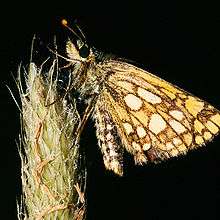Chequered skipper
| Chequered skipper | |
|---|---|
.jpg) | |
 | |
| Scientific classification | |
| Kingdom: | Animalia |
| Phylum: | Arthropoda |
| Class: | Insecta |
| Order: | Lepidoptera |
| Family: | Hesperiidae |
| Genus: | Carterocephalus |
| Species: | C. palaemon |
| Binomial name | |
| Carterocephalus palaemon (Pallas, 1771) | |
The chequered skipper or Arctic skipper (Carterocephalus palaemon) is a butterfly of the family Hesperiidae.
Description
This butterfly has a wingspan of 29 to 31 mm. The uppersides are a dark brown with a dusting of orange scales at the base of the wings and golden spots, giving it its English name of chequered skipper. The basic pattern on the underside is similar but the forewings are orange with dark spots, and the hindwings are russet with cream spots rimmed in black. The sexes are similar although females are generally slightly larger.
Distribution
It is widely distributed in northern and central Europe although not found in Italy, Portugal, Ireland, Denmark, and only found very locally in Spain, the UK, and Greece. Its range extends across Asia and Japan and also into North America (where it is known as the Arctic skipper), across southern Canada and the parts of northern United States including New England, the Great Lakes area and the northwestern States, as far south as northern California. It is generally considered a woodland butterfly and breeds in and around damp woodland, favouring clearings and woodland paths and seems to have a particular attraction to blue woodland flowers.
British population
The chequered skipper has been extinct in England since 1976 but has stable populations in western Scotland. Attempts to reintroduce the butterfly to England were started in the 1990s. It was previously quite widespread in the midlands of England with isolated populations as far afield as Devon and Hampshire. It is thought that the cessation of coppicing in English woodlands is the main cause of its extinction. It was only discovered in Scotland in 1939 where it is found in grassland on the edges of open broad-leaved woodland.
Life cycle
The eggs are laid singly on tussocks of grasses. In Scotland most eggs are laid on purple moor grass (Molinia caerulea). In England most foodplant records were on false brome (Brachypodium sylvaticum) but it may have used Bromus spp. as it does in continental Europe. In the USA, purple reedgrass (Calamagrostis purpurascens) is a noted foodplant. They are laid in June or July and take about 10 days to hatch. On hatching the larvae make shelters from rolled grass blades tied with silk from where they emerge at night to feed. In the autumn they construct a hibernaculum by drawing together several blades and the fully grown larvae spend the winter here. Before hibernation they are a pale green, after hibernation they are a pale beige. Upon waking the following spring they make no attempt to feed and will rest on a blade of grass for up to a week before pupating. The pupae are a pale buff colour with dark lines running along the length and are well camouflaged. About five or six weeks later the adult emerges and can be seen on the wing between May and July depending on the latitude (later further north). A very active butterfly, it needs a lot of nectar and sunshine. However, they are less strictly diurnal than other skippers. Although preferentially flying from the late morning to dusk, they may be found before dawn and some time after dusk too (Fullard & Napoleone 2001).
Images
- Mating
.jpg)
.jpg)

.jpg)
.jpg)

See also
| Wikimedia Commons has media related to Carterocephalus palaemon. |
References
- Asher, Jim et al. The Millennium Atlas of Butterflies of Britain and Ireland. Oxford University Press.
- Brooks, M. & Knight, C. A complete pocket guide to British Butterflies. Jonathan Cape Publishing.
- Fullard, James H. & Napoleone, Nadia (2001) Diel flight periodicity and the evolution of auditory defences in the Macrolepidoptera. Animal Behaviour 62(2): 349–368. doi:10.1006/anbe.2001.1753 PDF fulltext
- Ravenscroft, Neil (1996) The Chequered Skipper. Butterfly Conservation, Colchester, UK, 20p.
External links
- ARKive - images of life on earth, chequered skipper
- Chequered Skipper page from Butterfly Conservation.
- Chequered Skipper page from European Butterflies and Moths.
- Chequered Skipper page from Sunart Oak Woods, Scotland.
- Chequered Skipper page from Scottish Natural Heritage.
- Chequered Skipper page from UK Butterflies.
- Arctic Skipper, Butterflies of Canada
- Butterflies and Moths of North America page including a United States distribution map.
- Chequered Skipper page from greennature.com..
- Digital Atlas of Idaho Arctic Skipper page.